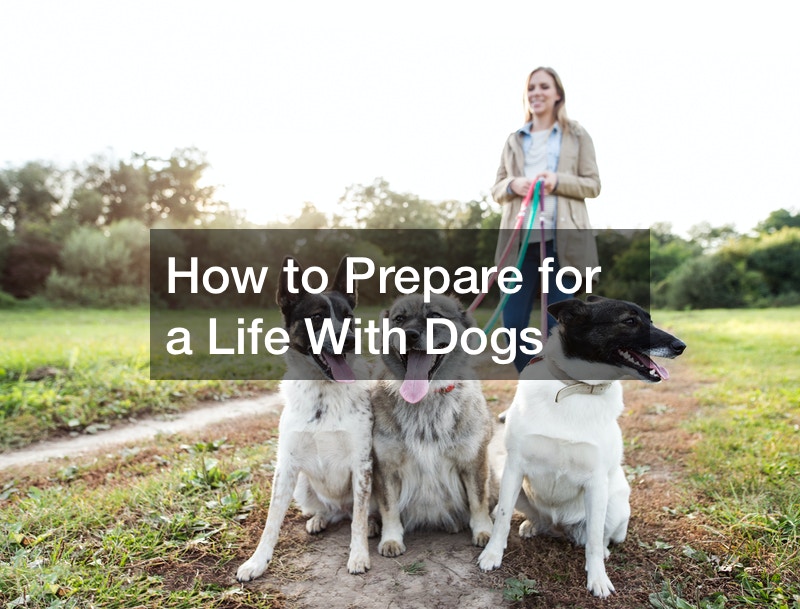
A dog is considered a man’s best friend, but they’re more than just companions because they can be trained to work alongside their owners. When you want to train your dog to work alongside you, the aim should be to regenerate the art of dog handling based on the dog’s instincts. This will help you achieve a greater working relationship with your dog, and if you’re using it to herd livestock, you’ll find your livestock quieter and more cooperative.
When training your dog to work alongside you, use positive reinforcement and set boundaries for your dog from the word go, and you’ll find that your working relationship is solid. It sounds easy, but it requires work; What you think you’re communicating to your canine companion should be the message it’s receiving. This eliminates frustration on your part and confusion for the dog. In this review, we’ll look at how to train your dog to work alongside you if you have an active job. We’ll also look at some of the jobs that dogs can do.

Which Jobs Can Dogs Be Trained to Do?
All dogs can get to work and help their owners carry out their tasks. However, depending on their breed and personality, dogs are cut out for different tasks, including:
Delivery
Delivery dogs are important in some areas. For instance, they can be attached to sleighs in snowy areas to help transport food, medicine, etc. When you have a pack of dogs, you can use them for heavy equipment services delivery instead of hiring heavy equipment rentals.
Detection
Dogs can also be used to sniff out specific outlawed substances like drugs, explosives, firearms, etc. Some of the dogs trained to detect include those in a firehouse, military, and police. Dogs can also track down individuals like those evading a bail bondsman. Therefore, if you offer 24 hour bail bond services, you can train your dog to work alongside you. Teaching a dog to detect requires time, consistency, and special equipment.
Entertainment
Dogs can also be utilized in the entertainment industry, and although people don’t see this as crucial, they are important as any other. Dogs working in entertainment can be used in various capacities, including:
Mascots: Some companies and schools prefer dogs to be their mascots
Movie stars: Some dogs can be trained to be co-stars in movies
Show dogs: some dogs can be trained to show off talents like running
It’s worth noting that while entertainment dogs don’t undergo the same training as detection or tracking dogs, a lot of work goes into training them to work alongside humans in the entertainment industry. For instance, show dogs must have special skills and be obedient to their handlers. On the other hand, dogs that appear in films as co-stars are recruited by a film staffing agency and need to learn new tricks to help them tackle any challenges they face.
Herding
Dogs can be used to carry out routine tasks like herding livestock. On a farm, a herding dog is used to keep other animals in line, such as cattle, sheep, horses, etc. To onlookers, it might seem that the dog only barks and chases herds around, but nothing could be further from the truth. The dog needs to be trained to handle animals, so they don’t stray too far. Also, they protect animals from intruders like coyotes, jackals, etc.
Military Work
Many people don’t consider dogs useful for military professionals, but canines help in various situations. For instance, they can help survey an area and sniff out any explosives in a battleground so that operators don’t step on them. Moreover, since dogs working in the military are trained for search and rescue missions, they can use their strong sense of smell to pick up the scent of a missing person and track them down.
Police Work
Dogs can also be utilized in police careers and are commonly known as K-9s. They can be used to track down missing people, drugs, or explosives. They can also be used to chase down suspects evading policemen and women. K-9s are well trained and can even be taken by their handler to a shooting range for extra training.
Search-and-Rescue
While search-and-rescue can be part of a job like the military, it’s also a career field. Search and rescue operators can use highly trained dogs to look for missing people. For instance, a dog trained in search and rescue will come in handy when there is a collapsed building.
Tracking
Dogs can also be used by their owners for tracking. This is especially handy for people who are into hunting as a daily activity because dogs can use their strong sense of smell to track prey. Moreover, they can also use their strong eyesight and hearing for tracking as well.

Tips On How to Train Your Dog to Work Alongside You
Understand How Dogs Are Trained
The first tip on how to train your dog to work alongside you is to understand how dogs are trained. Typically, there are two methods of training a dog, including:
Aversive-Based Method
The aversive-based method is training a dog by using positive reinforcement. You reward the dog only for behaviors that you want it to retain. On the other hand, you use techniques like harsh scoldings, loud and disturbing noises, and physical corrections to punish negative behaviors and get your dog to act how you want.
Reward-Based Method
On the other hand, in the rewards-based method, you reward your dog whenever it does something good. Rewards can be belly rubs, toys, treats, etc.
If you decide to reward your dog with treats, you should give it a small piece of cheese, chicken breast, or liver. Store-bought treats can also work, albeit in distraction-free environments. In environments with distractions, you need to bring out the good stuff.
Some people believe that reward-based training creates an event sequence for dogs, associating their owners with happy feelings whenever they do what they’re told. Aversive-based training is vice-versa; the dog fears you, and the fear means your dog will do what you tell it to do to avoid making you angry. The method you use is ultimately up to you.
Understand How Dogs Learn
The second tip on how to train your dog to work alongside you is to start early is understanding how dogs learn. Dogs learn like small kids; they mostly care about immediate consequences. As they develop, they begin to understand your words. Several intelligent breeds like Dobermans, German shepherds, and golden retrievers respond to as many as 250 words. However, all dogs react mostly to the tone of your voice rather than the words you say. That said, there are four types of dog intelligence recognized by experts, including:
Instinct (Prey Drive)
The first key to successfully training a dog is to identify and comprehend the dog’s working instincts. For instance, hunting and survival are what propels today’s herding dogs. You need to modify it and direct this instinct towards something useful.
Obedience
The second key to training a dog is obedience through positive reinforcement. Your dog should obey commands like release, sit, stay and stop. You can train your dog in an area with little to no distractions, then move them to an area with lots of distractions. For instance, you can start walking and see how your dog responds to commands you issue. If the response is great, you can proceed to command stock.
Command On Stock
The third key to successfully training a dog is command on stock. This is a blend between balance, commands, obedience, and off balance. Commence training in a controlled area, move to a less controlled area, then move to a bigger area. The trick is commanding and enforcing the commands. If this doesn’t work, go back to the controlled area. Consistency and repetition help your dog gain clarity regarding any commands you issue.
Stockmanship
Stockmanship is the fourth key to successfully training a dog; knowing where to position yourself and your dog to influence stock movement. Whether it’s herding cattle or tracking something, the key is obtaining stock flow via respect instead of force.

Start Early
The third tip on how to train your dog to work alongside you is to start early. Dogs learn quickly, and while you shouldn’t start training your dog when it’s too young, you also shouldn’t begin when it’s fully mature. Start training your dog when it’s about four months old; by this age, it has been inoculated for protection and is old enough to understand basic commands. For instance, your dog can be your guide in your CDL driver improvement class.
Note that if you want to use your dog for an active job, you should introduce it to people of various ages and in a different location. However, as you introduce your pup to new stimuli, you shouldn’t force it to behave in a certain way. Why? Because this can instill fear. Instead, you should positively reinforce good behavior by praising your dog.
Use the Right Tools
The fourth tip on how to train your dog to work alongside you is using the right tools to enhance your dog’s skills. For instance, a working dog might need to be leashed in some cases, so you should acclimatize your dog to the feel of a leash early on. You can also use different training tools like a clicker. This tool works best when paired with positive reinforcement. For instance, when your dog adheres to a command, click the tool and reward them. This makes it easier for them to associate the clicking sound with good behavior.
Know Dog Commands
Knowing dog commands is the fifth tip on how to train your dog to work alongside you. According to the AKC (American Kennel Club), there are five basic commands that a trained dog should respond to; they include:
Come by: the dog should move clockwise
Away to me: the dog should move counter-clockwise
Lie down: the dog should stop moving and lie down
Walk up: the dog should walk up to its owner or a herd (cattle or sheep)
That will do: the dog should come back to its owner.

Control Consequences Effectively
The sixth tip on how to train your dog to work alongside you is effectively controlling consequences. Your dog should understand there are consequences for inappropriate behavior. For instance, if the dog likes to jump at people when greeting them, it can be dangerous, especially for small kids and seniors. Train the dog not to jump at you; if your dog jumps at you, don’t greet them or give them any attention.
Continue doing this until your dog stops jumping. When your dog stops jumping, reinforce this behavior with bell rubs, a new toy, or a treat. This will ensure that the dog is professional and never jumps at people. Note that this isn’t specifically meant for preventing jumping at people; you can also use it for other inappropriate behaviors.
Stimulate Your Dog
The seventh tip on how to train your dog to work alongside you is stimulation. A working dog isn’t lazy, so keep your dog’s mind active with games, playtime, and a host of toys. For instance, you can use food puzzles to stimulate your dog.
Remember that physical stimuli are as important as mental stimuli, especially since a dog that works alongside you will move a lot. Therefore, you can stimulate it with exercise to incorporate agility into its routine. Adding agility is great because it helps your canine companion think as it moves. However, don’t push your dog past its limits; if you notice it is exhausted, allow it to rest, then proceed with exercises.
In conclusion, that’s how to train a dog to work alongside you. Training isn’t an overnight process; it needs time and consistency. There are many tips to train a dog to work alongside you, but a good relationship rises above all.



